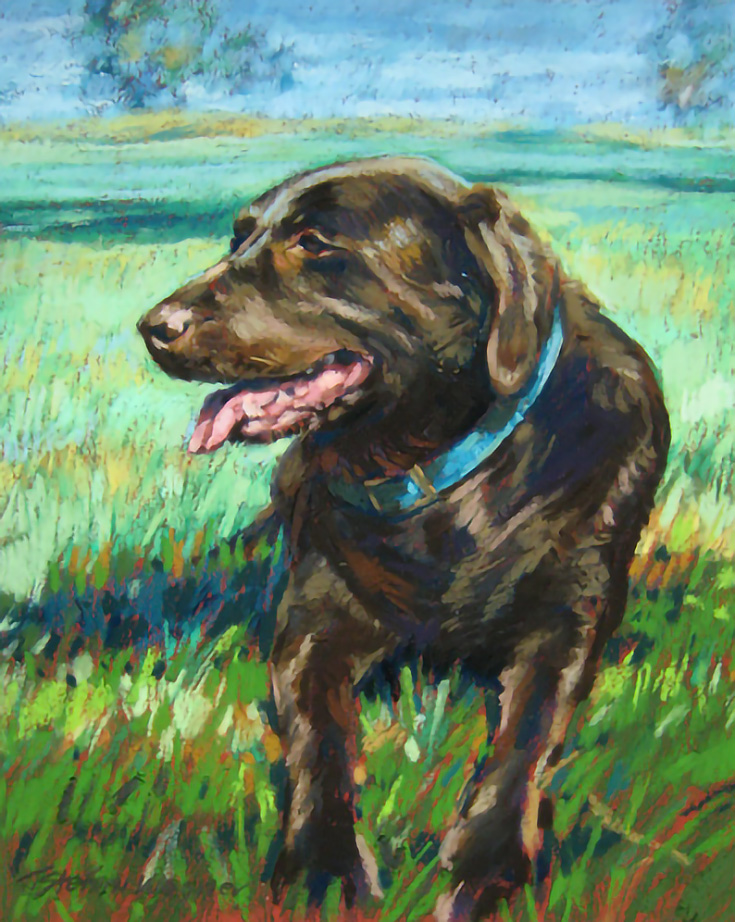Many years ago, I attended art school at the University of Michigan and like many idealistic young painters, I dreamed of becoming a full-time artist. I envisioned days painting major works and living a life full of color and creative possibilities. At some point, however, reality set in. I very much liked to eat, and it was obvious that I would not be able to support either myself or a future family as a struggling artist.
So, with just three months remaining before graduation, I transitioned to graphic design and spent the next 30 years in a successful advertising career. . . always planning to paint, but seldom finding the time.
A year ago, I allowed my dream to materialize. I sold my agency and now paint whatever I want, as often as I want. I am successfully represented by 3 galleries and various art consultants and I paint constantly, mostly in pastel. My subjects include the things many artists paint: landscapes, cityscapes, skyscapes and nudes.
And. . . also pet portraits.
HUH? WHAT? Animal paintings were never part of my plan! Somehow they didn’t seem important enough for a professional artist. . . no gravitas, no grandeur, no glamour.
But after creating a pastel painting of my Australian Shepherd and then another of my sister’s Maltese, the subject matter increasingly interested me. I was getting commission requests from people who wanted to save the memory of their favorite furry friend. And I found myself enjoying both the process as well as the joy expressed by the painting’s recipient.
It took me a while, but I learned a lot during this process. And many of the things I learned are applicable to any piece of art I create, not just paintings of four-legged friends.
For instance, good photography is a must when painting pet portraits. Flat photos with no light source or an image that doesn’t reveal the animal’s personality will result in a disappointing piece of art.
I try to explain this to the people who commission me to paint their animals and, for the most part, they understand. I request multiple images and together we choose one with the potential to become a good composition.
I have, however, had a few pet owners who did not understand the process—at all. I recall one woman who desperately missed her little terrier that had recently passed away and wanted a painting through which to remember him. She assured me she had good reference photos and would email them to me.
But unfortunately, when I opened the image, I was stunned to see two photos of the dog running on a beach—away from the camera. They were basically photographs of a dog’s hind end in motion. When I called to tell her I had only received “rear-view” images, she replied, “Yes, I know. These are all I have, but I want you to paint a close up of his face. I thought you could work from these.” I had no idea how to respond. . . and obviously, that was one commission that fell through.
When possible, I prefer to shoot my own photography of the animal. I charge a bit extra to do this, but I always have much better results when I can control the light, composition and setting. And, when the animal is well trained, it is almost always a pleasant experience. I’m able to meet the owner and get to know the temperament of my new subject. The actual painting comes much easier with this information in hand.
However. . . I have learned that a “well-trained dog” is a relative term, often subject to the unconditional adoration of the owner. I’ve arrived at quite a few photo sessions expecting an obedient canine, only to find a wild and rambunctious animal. “Sit,” “Stay” and “Down” were not part of the dog’s vocabulary and the owner had no issue with the fact that their 90-pound pet greeted me with its paws on my shoulders.
In these cases, a 30-minute photo shoot usually turns into a 2-hour extravaganza that ends only when I have absolutely exhausted the animal and can sneak in a few half-way decent shots of it splayed out and panting.
For the most part, however, animal portraits are a joy. I call them my guilty pleasure. I get a real kick out of starting with a blank piece of paper and slowly teasing out the likeness of an adored family pet.
I usually start on a medium-colored Art Spectrum sheet with a dark underpainting. It is imperative to get this first drawing step correct and sometimes I will “grid-up” the image from the original photo. But I never feel the need to completely recreate the original photographic reference, because I know the owners want me to infuse some of my own creativity into the piece.
I build volume and likeness by gradually using lighter values and softer pastels until I get to my favorite part—the details of the animal’s expression. Watching the sparkle of personality emerge is waaaaaay fun!
And then it’s finished. And handing the finished portrait to the client is one of my favorite and most rewarding moments as an artist.
It’s not uncommon for people to become emotional and I’ve even had a few grieving pet owners break down and cry. I can’t pretend its because my artwork is so stunningly wonderful. . . no, it has much more to do with the fact that someone thought their sweet little pup or kitten was really important—and well worth the time and talent needed to create a piece of art.
To learn more about Jill and her artwork, please visit jillwagnerart.com.
This post may contain affiliate links.




